 Research Article
Research Article
Competing Risk Analysis on Leading Causes of Death: Evidence from University of Ghana Hospital
Felix O Mettle1, Emmanuel K Aidoo2* and Enoch Nii Boi Quaye3
1Department of Statistics, University of Ghana, Ghana
2Department of Statistics University of Ghana, Ghana
3Kent Business School, Ghana
Emmanuel K Aidoo, Department of Statistics, University of Ghana, Ghana.
Received Date: July 08, 2022; Published Date: July 22, 2022
Abstract
Human beings are exposed to various risks of death such as cancer, heart disease, accidents, stroke, diabetes, AIDS, etc. Therefore, many risks are competing in the life of an individual. Hence, one needs to study the likelihood of dying from a particular risk in the presence of all other risks and the probability of dying when a specific disease is controlled in the population. This paper studies competing risks of three selected causes of death: cardiovascular disease, HIV/AIDS, and malaria and the interdependency of the three causes of death. Secondary data were extracted from the administrative records unit of the University of Ghana Hospital. The data include the cause of death, age and gender from 1979 to 2019. The study adopted a multiple decrement table where the crude, net and partial probabilities were calculated. The study found that among the three specified diseases, the probability of dying from malaria was higher for children less than five years. Regarding the youth, the probability of dying from HIV/ AIDS in this age range was higher, and in the older ages, the probability of dying from cardiovascular disease was higher. The study also concluded that people would live longer than expected if cardiovascular disease and malaria were controlled in Ghana.
Keywords: Competing risk; Multiple decrements; Crude probability; Net probability; Partial probability
Introduction
Every human is continuously exposed to many risks of death, such as cancer, heart disease, accidents, stroke, diabetes, AIDS, etc. Hence, cause-specific mortality analysis must consider various risks competing for an individual’s life. According to [8], competing risks arise in studies in which individuals are subject to several potential failure events, and one event might impede other events. For example, the cause of failure in bone marrow transplantation can be a relapse, death in remission, or other causes. Malaria is one of the leading causes of infant death in Africa now. Suppose we wish to assess malaria as a cause of infant death. Competing risk analysis enables us to determine the baby’s probability of surviving in the first year if the cause of death due to malaria no longer exists. In addition, competing risk analysis lets us know the interdependency of the different causes of death in the population.
The study of survival and the application of the life table to competing risk require understanding these types of probabilities of death due to a specific risk: crude probability, the net probability, and partial crude probability. Now crude probability is the probability that an individual alive at time x will die in the interval ( x, x + 1) from risk in the presence of all other risks in the population. Net probabilities are the probability that an individual alive at x will die in the interval ( x, x + 1) a particular risk is the only risk of death acting in the population or the probability that an individual alive at x will die in the interval ( x, x + 1) if a particular risk is eliminated as a risk of death from the population and the partial crude probabilities is the probability that an individual alive at x will die in the interval ( x, x + 1) from a particular risk if another risk is eliminated from the population.
In the human population, the net and the partial crude probability are not estimated directly but through the relationship with the crude probabilities. According to [2], the concept of competing risks analysis originated in 1766 from the question of mandatory vaccination against smallpox and attempts were made to evaluate its possible effects. French mathematician Daniel Bernoulli researched the impact of smallpox on the longevity of humans.
HIV/AIDS, cardiovascular disease, and malaria are major global public health threats that undermine developing countries, especially in Africa [3], [15]. Approximately 5 million lives are lost annually due to these diseases, which also have consequences on the social-economic development of the nation [12]. These diseases are mostly affected by a particular age group. The death of malaria is mainly seen in children under five years, while cardiovascular diseases mostly happen to aged people [3]. There are many studies on malaria, HIV/AIDS and cardiovascular diseases. However, studies on this area only consider the crude analysis of the diseases without looking at the interdependency of the causes of death. For example, [5] analysis the impact of HIV/AIDS in Sub-Saharan Africa. [13] examined the patterns of cardiovascular disease mortality in Ghana. With respect to malaria, [11], analysed the prevalence of asymptomatic malaria infection among primary school children in Tanzania.
This paper conducts a crude analysis of these diseases and the interdependency of the causes of death using the net and partial crude probability.
The rest of the paper is organised as follows. The following section is a material and methods that includes the theoretical framework, data descriptions and analysis strategy. We then have results and discussions leading to conclusions of the study.
Methods And Materials
This section covers the theoretical framework that captures the mathematical basis of the analysis and the analysis strategy.
Theoretical Framework
Suppose death are categorised into k causes, and the number of death due to k causes are denoted as di1,di2,di3.....dik where

and


Let lo denote the initial population in the beginning of the cohort and i l the number of survivors at the beginning of the interval (xi,xi+1).
The probability that an individual will die in the interval (xi,xi+1) from a specific cause is Rλ (λ = 1, 2, 3,, k) and the probability of surviving satisfy the conditions



Therefore, the conditional probability of dying from a specific cause diλ and li+1 is multinomial with the probability distribution

and the probability generating function (p.g.f) can be denoted as


From (7), (8) and (9) the joint probability distribution of the random variables di1,....diλ,dλ+1 for i=0,1,2....n is

The crude probability Qiλ can be derived from (10) using the maximum likelihood principle. Given the initial population l0 , the expectation of the random variables diλ and li+1 is given as

According to Neyman’s theory, the best estimators of a parameter minimise the reduced form of

From (4)

Then substituting Pi in (13) into (12) will make it easier in minimising values of ˆQiλ .

Therefore

Summing overλ in (15),

Substituting (16) into (15)

and

The relation between net probability and crude probability
According to Chiang (1970), for each risk, there is a corresponding force of mortality, which is presented byμ (τ ;γ ) . Therefore
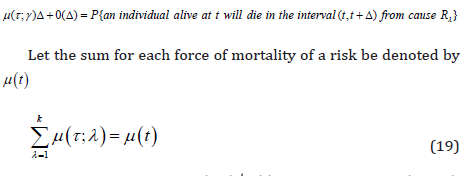
and each risk R_γ the ratio depends only on (xi,xi+1) and not on t .
The probability that an individual alive at will live in the interval (xi,xi+1) without specifying the cause of death is given as





The net probability of death i qλ in the interval (xi,xi+1) when Rλ is the only risk acting in the population is defined as




Substituting (18) into (19), we get









Analysis Strategy
Secondary data were extracted from the records unit of the University of Ghana Hospital. The data consist of information on the cause of death and gender from 1979 to 2019. The causes of death were grouped into four: cardiovascular diseases, HIV/AIDs, malaria, and ‘other’ causes of death. The study adopted a multiple decrement table where the crude, net and partial probabilities were calculated. The crude probabilities were calculated with respect to equation 18 for cardiovascular diseases, HIV/AIDs and malaria. The graphical presentations of them are presented in Figure 1.1. The net probabilities of dying from cardiovascular diseases, HIV/AIDs and malaria based on equations 36 were calculated. Graphs of partial probabilities computed based on equation 37 of cardiovascular diseases are also displayed.
Results And Discussions
This section first describes the data and presents the crude probabilities, net probabilities and partial probabilities of the leading causes of death in Ghana.
Descriptive Statistics
Table 1: Descriptive Statistics.
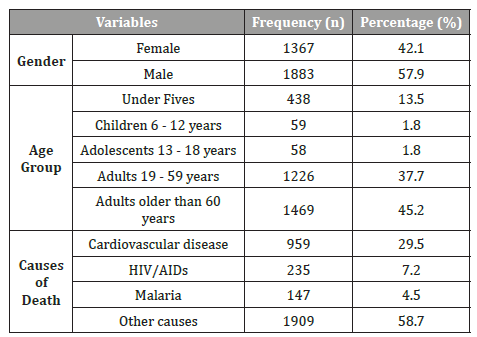
The distribution of gender, age, class and the causes of death were computed and presented in Table 1. It was found that 1883 (57.9%) of the respondents were male. The study also recorded that 1469 (45.2%) were adults older than 60 years, while 959 (29.5%) had the cardiovascular disease as their leading cause of death. This implies that most of the death recorded were males and were in the age group of 60 years, with cardiovascular disease as their leading cause of death. These results confirmed with [16] that the life expectancy of males is lower than females and therefore dies more than females. [6] also explained that aged people are likely to die, forming the majority of the dead population. According to Townsend (2018), cardiovascular disease remains the leading cause of death in most countries (Table 1).
Crude Probabilities
Figures 1.1 display the crude probabilities for cardiovascular diseases, HIV/AIDS and malaria. From Figure 1.1, it was observed that the crude probability of dying from malaria was higher than the rest of the diseases for children under five years. This implies that among all three diseases, the chances that a child less than five years will die of malaria is higher. This result affirmed [10] that in Africa, children under five years of death due to malarial are very high compared to other age groups. In that age group (under five years), the crude probability of cardiovascular disease and that of HIV/AIDS were negligible (<0.001). From 20 to 40 years, the crude probability of HIV/AIDS in this age range was higher. This implies that in the presence of the other diseases, people aged 20 to 40 years have a higher probability of dying from HIV/AIDS. [7] explained that youth are sexually active, and sexual transmission remains the major mode of HIV transmission in Ghana, increasing the risk of the youth having such diseases. Regarding the crude probability of people above 40, cardiovascular disease was higher. This implies that death due to cardiovascular diseases are often experienced by these aged groups. This result was confirmed by [4], who explained that ageing reduces the efficiency of homeostatic regulation, thereby promoting an increase in tissue damage, rate of morbidity, and mortality. Progressive loss of physiological function of cardiomyocytes and vascular smooth muscle cells has been associated with cellular ageing and puts aged people at high risk of cardiovascular diseases.
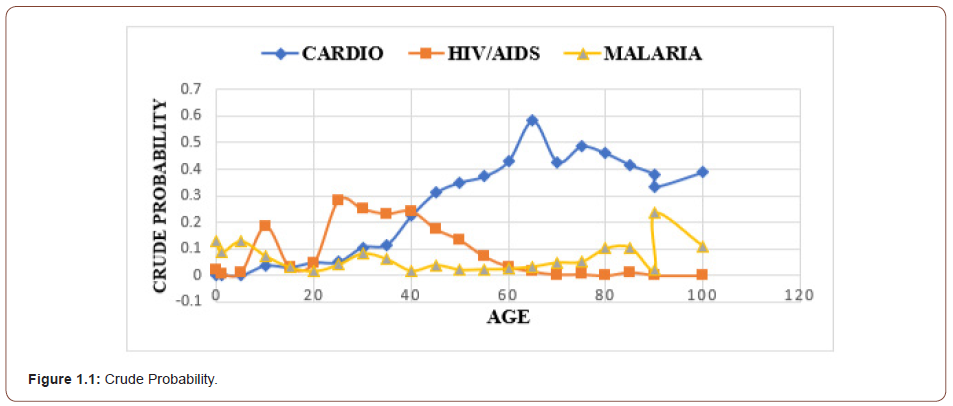
Net Probability
The net probabilities of the three diseases were also calculated, and the result can be seen in Figure 1.2. From Figure 1.2, it can be seen that the net probability of cardiovascular diseases was lower than the rest of the diseases. This means that the probability of dying if cardiovascular disease is eliminated from the population is lower than if malaria and HIV/AIDS diseases are eliminated from the population. This is because, among the three diseases, the rate at which people die of cardiovascular disease was higher. Therefore, if the disease is eliminated, the impact will be more felt than the rest of the diseases.
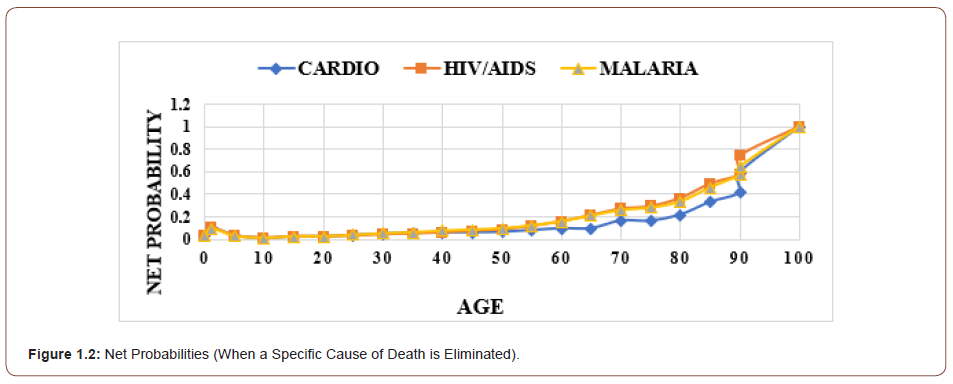
Partial Crude Probability ( Qiλ.1 ) of Cardiovascular Diseases
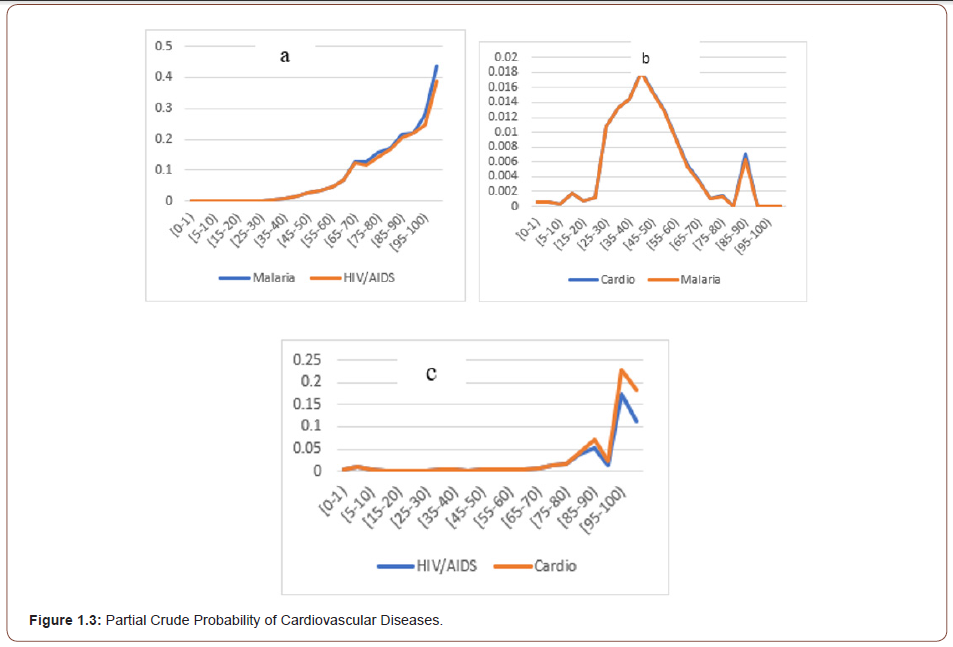
The Partial probability of cardiovascular disease, HIV/AIDS and Malaria being eliminated in the population was computed and presented in Figure 1.3.
Diagram “a” represents the partial crude probability of cardiovascular diseases when malaria and HIV/AIDS are eliminated from the population. It can be seen that the probability of dying from cardiovascular diseases when malaria is eliminated from the population is higher than when HIV/AIDS is eliminated. Hence, if HIV/AIDS is controlled, the rate of dying from cardiovascular diseases will be reduced. Therefore, the dependency on cardiovascular and HIV/AIDS is higher than the dependency on cardiovascular and malaria.
Diagram “b” represents the partial crude probability of HIV/ AIDS when malaria and cardiovascular are eliminated from the population. It can be seen that there is no significant difference between the probabilities of dying from HIV/AIDS when malaria is eliminated and when cardiovascular is eliminated from the population.
Diagram “c” represents the partial crude probability of malaria and why cardiovascular diseases, and HIV/AIDS are eliminated from the population. It was revealed that when cardiovascular diseases are controlled, the rate at which people will die from malaria will be reduced.
Conclusion
Among the three specified diseases, cardiovascular disease, HIV/AIDS, and malaria, for children under five years, the crude probability of dying from malaria was higher. Regarding the youth, the crude probability of HIV/AIDS in this age range was higher, and with the older ages, the crude probability of cardiovascular disease was higher. The study also concluded that the probability of dying if HIV/AIDS is eliminated from the population is higher than when malaria or cardiovascular diseases are eliminated. Also, males of 45 to 70 years have a higher risk of dying of cardiovascular disease when HIV/AIDS or malaria is eliminated from the population than the females of the same age group (45 to 70 years). There is a dependency on cardiovascular and HIV/AIDS than the other dependency (cardiovascular and HIV/AIDS, HIV/AIDS, and malaria).
Acknowledgement
None.
Conflict of Interest
No conflict of interest.
References
- Chiang C L (1970) Competing risks and conditional probabilities. Biometrics: 767-776.
- David H A, Moeschberger M L (1978) The Theory of Competing Risks: HA David, ML Moeschberger. C. Griffin.
- Ezechi O, Odberg Petterson K, Byamugisha J (2012) HIV/AIDS, tuberculosis, and malaria in pregnancy. Journal of Pregnancy.
- Fajemiroye J O, Cunha L C D, Saavedra Rodriguez R, Rodrigues K L, Naves L M, et al. (2018) Aging-induced biological changes and cardiovascular diseases. Bio Med Research International.
- Fortson J G (2011) Mortality risk and human capital investment: The Impact of HIV/AIDS in Sub-Saharan Africa. The Review of Economics and Statistics 93(1): 1-15.
- Grühn D, Sharifian N, Chu Q (2016) The limits of a limited future time perspective in explaining age differences in emotional functioning. Psychology and aging 31(6): 583-593.
- Ippolito G, Levy J A, Sonnerborg A, Mugusi F, Dianzani F (2013) AIDS and HIV infection after thirty years. AIDS research and treatment.
- Klein J P (2006) Modelling competing risks in cancer studies. Statistics in medicine 25(6): 1015-1034.
- Luptakova I D, Bilikova M (2014) Actuarial Modeling of Life Insurance Using Decrement Models. Journal of Applied Mathematics, Statistics and Informatics 10(1): 81-91.
- Murray C K, Bennett J W (2009) Rapid diagnosis of malaria. Interdisciplinary Perspectives on Infectious Diseases.
- Nzobo B J, Ngasala B E, Kihamia C M (2015) Prevalence of asymptomatic malaria infection and use of different malaria control measures among primary school children in Morogoro Municipality, Tanzania. Malaria Journal 14(1): 1-7.
- Olonade O, Olawande T I, Alabi O J, Imhonopi D (2019) Maternal mortality and maternal health care in Nigeria: Implications for socio-economic development. Open access Macedonian journal of medical sciences 7(5): 849-855.
- Sanuade O A (2012) Trends of Cardiovascular Disease Mortality in Ghana: A Case Study of Mortality Cases at Korle Bu Teaching Hospital (Doctoral dissertation, University of Ghana).
- Townsend N, Nichols M, Scarborough P, Rayner M (2015) cardiovascular disease in Europe-epidemiological update. European heart journal 36(40): 2696-2705.
- Vitoria M, Granich R, Gilks C F, Gunneberg C, Hosseini M, et al. (2009) The global fight against HIV/AIDS, tuberculosis, and malaria status and future perspectives. American journal of clinical pathology 131(6): 844-848.
- Zarulli V, Jones J A B, Oksuzyan A, Lindahl Jacobsen R, Christensen K, et al. (2018) Women live longer than men, even during severe famines and epidemics. Proceedings of the National Academy of Sciences 115(4): E832-E840.
-
Felix O Mettle, Emmanuel K Aidoo, Enoch Nii Boi Quaye. Competing Risk Analysis on Leading Causes of Death: Evidence from University of Ghana Hospital. Annal Biostat & Biomed Appli. 4(4): 2022. ABBA.MS.ID.000595. DOI: 10.33552/ABBA.2022.04.000595.
Competing risk, Multiple decrements, Crude probability, Net probability, Partial probability
-

This work is licensed under a Creative Commons Attribution-NonCommercial 4.0 International License.






